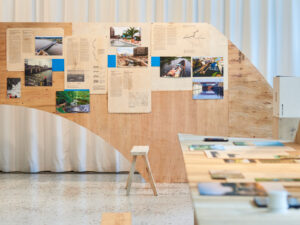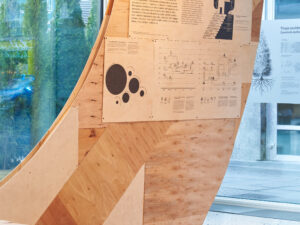
Architecture – durable, useful, beautiful and… incredibly harmful. The construction industry and life-cycle costs generated by buildings are responsible for over ⅓ of world CO2 emissions – one of the main causes of climate change.
Cities and buildings nowadays operate in a way that disturbs nature’s cycles, pollutes and devour vast areas of land. On the other hand, humans are unable to function outside of the built environment. Architecture provides proper and safe living conditions, creates spaces of everyday existence for numerous people all over the world.
The anthropocene is an era of humans, an era of anthropogenic changes that result in global climate catastrophe. The name of this exhibition signifies ambivalence – it is both narcissistic (what we present is testament to the human power) and critical towards the current state of the world. We do not, however, intend to instill hopelessness in our visitors. We can still stop (or rather limit) the destruction of our collective home. The exhibition is structured around the doughnut economics diagram – a compass for the 21st century. The interior of the doughnut is delimited by the social foundation – minimal appropriate living conditions, the external limit marks the ecological ceiling – the planetary boundaries in landscape, biodiversity, water, climate, land transformation and pollution, whose transgression causes irreversible damage to the natural world. Safe and just space for humanity is encapsulated between these two boundaries. It is there that we believe architecture would best fulfill its purpose.
The mosaic of examples presented in this exhibition delineates the context of current challenges in face of the climate crisis, allowing us to better understand the trials that lie ahead. We see architecture not only as an effect of global and local changes in the relationship between humans and nature, but also as a tool that shapes it. We present contemporary and historical designs, completed projects and technologies that impact the habitats of all species and beings. Installations in each ecological category offer us a look into architecture’s future and the roles it can play. Their authors looked for methods of architectural design and functionality that go beyond being not harmful to the planet and towards a regenerative environmental impact. These examples prove that there is another way for architecture.
Colophon:
Organized by: Narodowy Instytut Architektury i Urbanistyki
Co-organized by: Capital City of Warsaw
Scientific curator: dr hab. inż. arch. Bolesław Stelmach, prof. PŁ
Curators: Kacper Kępiński, Adrian Krężlik
Contributors: Pracownia Architektury Krajobrazu (Marta Tomasiak, Marta Przygoda), Centrala (Małgorzata Kuciewicz, Simone De Iacobis), Miastopracownia (Barbara Nawrocka, Dominika Wilczyńska), Kasper Jakubowski, Jan Szeliga i Krzysztof Janas, NAS-DRA (Paulina Grabowska, Oliwia Rybczyńska) , Jan Domicz, Simone Ruess, BIEL studio (Zofia Strumiłło-Sukiennik, Grzegorz Piotrowicz)
Sound installations: Dobrawa Czocher, Baasch
Exhibition architecture: Centrala (Małgorzata Kuciewicz, Simone De Iacobis)
Visual identity: Katarzyna Nestorowicz
Graphic design of the exhibition: Jerzy Gruchot (Full Metal Jacket)
Production: Weronika Sołtysiak
Licensing: Mateusz Włodarek
Accompanying program: Marta Baranowska, Katarzyna Domagalska, Anna Czarnota
Communication: Joanna Krupa, Dominik Witaszczyk
Editing: Urszula Drabińska
Translations: Natalia Raczkowska, Dorota Wąsik
Photo editing: Studio Avantura (Roland Nowak)
Implementation: Muh Crew (Jakub Henke, Łukasz Kowalski, Marcelina Dereń, Łukasz Rosiek, Paweł Łasiński, Radosław Jagucki, Kacper Kobus, Piotr Cwaliński, Michał Szulżyk, Krzysztof Mędrek, Kuba Puchatkiewicz)
Models: Onimo – makiety architektoniczne
Collaborative input: Muzeum Sztuki Nowoczesnej w Warszawie, Warbud SA, Dominika Dragan-Alcantara, Dorota Leśniak-Rychlak (współpraca redakcyjna / editorial collaboration), Aga Sukienniczak (współpraca kuratorska / curatorial collaboration)
Organisational input: Anna Brzezińska-Czerska, Monika Komorowska, Katarzyna Sałbut, Artur Wosz, Katarzyna Zachara
Acknowledgments: 55architekci, Adrian Bodhi, Afl architects, Agence Ter Paysagistes Urbanistes, Alisma Construction, Ana Tostões, Analog Studio, Ave Bureau, Bal Architektek, Bart Staszewski, Baumschlager Eberle Architekten, Biblioteka Uniwersytecka w Warszawie, Cave Bureau, Co-haty, David Brichs, De Urbanisten, Domino – grupa architektoniczna, Einszueins Architektur, Emmanuelle Bentz, Empreinte, Fallingwater Projects Western Pennsylvania Conservancy, Fundacja Instytut Architektury, Fundacja Mies van der Rohe, Grün Stadt Zürich, Hassell+, Hans Porochelt, Instytut Dokumentacji Architektury, Biblioteka Śląska, Instytut Biochemii i Biofizyki PAN, Jeju Studio Iwo Borkowicz, Kamil Bańkowski – Irart, Ken Schluchtmann, Kéré Architecture, Kothari Associates, Kuryłowicz & Associates, Lacaton & Vassal, Lindman Photography, Maciej Siuda Pracownia, Major Architekci, Miasto Kraków, Milena Szutkowska-Maj, Modraszek Kolektyw, Muzeum Architektury we Wrocławiu, Muzeum Historii Żydów Polskich POLIN, Muzeum Narodowe w Warszawie, Muzeum Śląskie w Katowicach, Narodowe Archiwum Cyfrowe, Nathanael Scheffler, Paweł Ulatowski, Philippe Rahm Architectes, Raumlaborberlin, Riegler Riewe Architekten, Sonovision, Studio A4, Surroundings Studio, Telewizja Polska, White Arkitekter, Workplace, X-Architects, XYstudio, Zofia Strumiłło-Sukiennik i Grzegorz Piotrowicz, Zukunftsgeraeusche
Collaboration: Adobe Stock, Agencja Wyborcza.pl, Alamy, Archiwum Architektury Hassana Fathy’ego, Amerykański Uniwersytet w Kairze, Archiwum Fundacji Ośrodka KARTA, East News, Forum Polska Agencja Fotografów, Galeria Le Guern, Grupa ZPR Media, Jakub Rodziewicz, Jan Domicz, Jan Goots, Karol Żurawski, Krzysztof Kalisz/OperatorKamery, Marcin Czechowicz, Michał Młynarczyk, Muzeum Akademii Sztuk Pięknych w Warszawie, Paweł Skowera, Polska Agencja Prasowa, Robert Fishman, Simone Ruess, Smith Archiwum, Tomasz Czernicki, Tomasz Kiełkowski Archifoto














